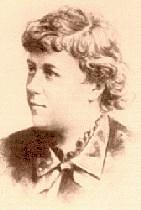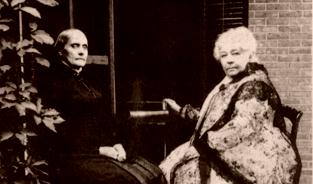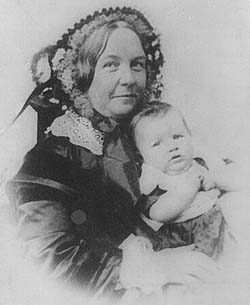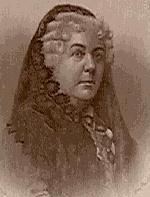

ELIZABETH CADY STANTON
1815 ~ 1902

Elizabeth Cady was born
12 November 1815
in Johnstown, New York.
Her father was Daniel Cady
a United States congressman
and eventually a judge of the
New York Supreme Court.
Elizabeth spent a great deal of time
in her father�s law offices
and learned of
the discriminating laws
under which a woman lived.
Her firsthand knowledge
of endless numbers of cases
concerning the tragic circumstances
that faced any woman
who chose to defy male supremacy
etched in stone
her determined ambition
to equalize the rights of her sex.
In 1840 she married
Henry Brewster Stanton,
a lawyer and abolitionist.
She agreed to honor Henry,
but refused to obey him
and the oath was stricken
from their marriage ceremony.
Elizabeth was determined
that their marriage
would start off on the right foot
as an equal partnership.
She was adamant in her desire
to keep her own name
~ Elizabeth Cady Stanton ~
as opposed to the customary
~ Mrs. Elizabeth Stanton.
In 1848 she circulated petitions
that helped to secure
the passage of a New York statute
giving property rights
to married women.
In 1848 she formulated
the first organized demand
for woman suffrage
in the United States.
In 1850 she began an association
with another outstanding suffragist,
Susan Brownell Anthony,
who managed the business affairs
of the suffragist movement
while Stanton did most of the writing.

Elizbeth and Susan
enjoyed a 40 year friendship
in which one supplemented the other
throughout difficult times.
They edited a women's rights newspaper,
the Revolution from 1868 to 1870,
and with Matilda Joslyn Gage,
the first three volumes of
The History of Woman Suffrage,
Six volumes from 1881 to 1922.
Elizabeth Cady Stanton
is believed to be the driving force
behind the 1848 Convention,
and for the next fifty years
played a leadership role
in the women's rights movement.
Somewhat overshadowed
in popular memory
by her long time colleague
Susan Brownell Anthony,
Stanton was for many years
the architect and author
of the movement's
most important strategies
and documents.
Elizabeth wrote of Susan
and the great task they shared:
I am the better writer
and she the better critic ~
and together, we have made arguments
that have stood unshaken
by the storms of many long years ~
agruments that no man has answered.
Though she became
increasingly estranged
from the mainstream
of the movement,
particularly near the end
of her career,
she maintained to the end
her long time friendship
with Susan Brownell Anthony.
Stanton had an early introduction
to the reform movements,
including encounters
as a young woman
with fugitive slaves
at the home of her cousin
Gerrit Smith.
It was at Gerrit Smith's home
that she also met her husband
Henry Brewster Stanton.
Soon after their marriage in 1840
they traveled to London,
where Henry Stanton was a delegate
to the World Anti-Slavery Convention.
There she met Lucretia Mott,
the Quaker teacher who served
in many of the associated
Temperance, Anti-Slavery
and Women's Rights organizations
with which Stanton is associated.
Denied seats at the convention,
as were all the women delegates,
Stanton and Mott discussed
the need for a convention
on women's rights.
Their plan came to fruition
when Mott again encountered Stanton
in the summer of 1848
at the home of fellow Quaker, Jane Hunt.
After a month of missionary work
on the Cattaraugus Reservation
of the Seneca Nation,
James and Lucretia Mott
were attending the annual meeting
of the Religious Society of Friends
at Junius, near Seneca Falls,
and staying at nearby Auburn
with Lucretia Mott's sister,
Martha Coffin Wright.
Stanton, Mott, Wright, Hunt
and Mary Ann McClintock
made the plan to call
the first women's rights convention,
initiating the women's rights movement
in the United States,
and Stanton's role as a leader
in that movement.
In 1851, Susan Brownell Anthony
was staying at the home
of fellow Temperance worker
Amelia Bloomer,
while attending an anti-slavery
meeting in Seneca Falls.
Stanton encountered
Bloomer and Anthony
on the street
recording the meeting
in her diary as follows:
How well I remember the day!
George Thompson
and William Lloyd Garrison
having announced
an anti-slavery meeting
in Seneca Falls,
Miss Anthony came to attend it.
These gentleman were my guests.
Walking home after the adjournment,
we met Mrs. Bloomer and Miss Anthony
on the corner of the street
waiting to greet us.
There she stood,
with her good earnest face
and genial smile,
dressed in gray delaine,
hat and all the same color,
relieved with pale blue ribbons,
the perfection of neatness and sobriety.
I liked her thoroughly,
and why I did not at once
invite her home with me
to dinner, I do not know.
History records the lasting relationship
between these two women
as well as the strains that resulted
from their different roles and priorities.

Unwilling to commit
to a vigorous travel schedule
until her children were grown,
Stanton wrote many of her speeches
for delivery by Anthony.
As the years wore on
the two held closely together,
splitting with many other women
as well as Gerrit Smith
and Frederick Douglass,
over the idea that suffrage for black men,
after emancipation should take precedence
over suffrage for women.
Elizabeth and Susan
along with Matilda Joslyn Gage led
The National Woman Suffrage Association,
opposing the concept of precedence
accepted by the less radical
American Woman Suffrage Association.
Almost thirty years after
the Seneca Falls Convention,
Stanton and Gage authored
The Declaration of Rights
of the Women of the United States,
which Anthony presented
~ uninvited ~
at the Centennial celebration
in Washington in 1876.
The Declaration was signed
in the Centennial Books of the
National American Woman Suffrage Association
by Stanton, Anthony and Gage,
as well as many later arrivals
to the movement such as
Virginia Minor, Lillie Devereux Blake,
Lucretia Mott, Mary Ann McClintock
and Amy Post, all of whom
were present at the 1848 Convention.
Elizabeth Cady Standon
died in 1902
and like Anthony and Gage
did not live to see women's suffrage
in the United States.
She is nonetheless regarded
as one of the true major forces
in the drive toward
equal rights for women
in the United States
and throughout the world.
All of the demands set forth in
The Declaration Of Sentiments
at Seneca Falls in 1848
have been extensively granted,
yet even though women are now
realizing more and more equality
it is wise for them to remember
that their fight is not finished
~ unfortunately ~
there are still snakes
in the garden.

Sources:
Encyclopedia Americana
World Book Encyclopedia
The New Book of Knowledge
New Standard Encyclopedia


